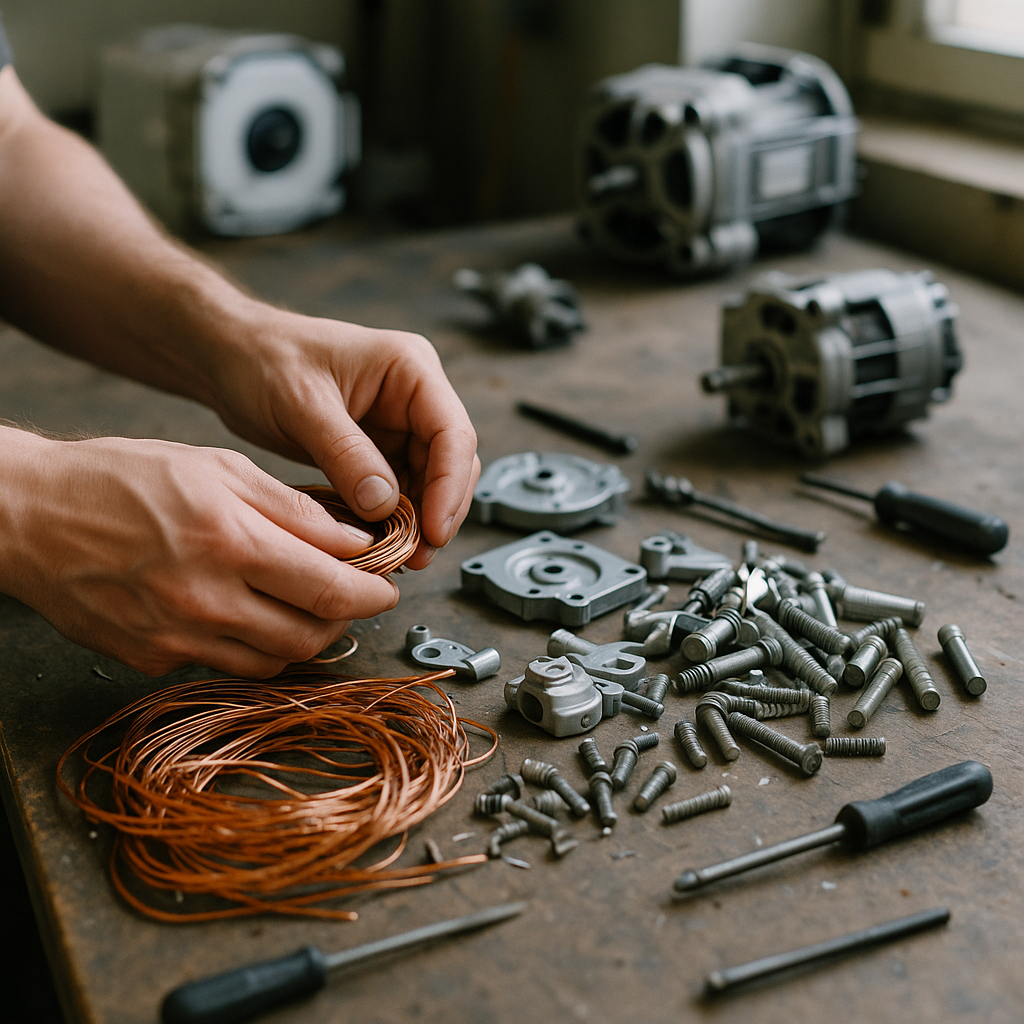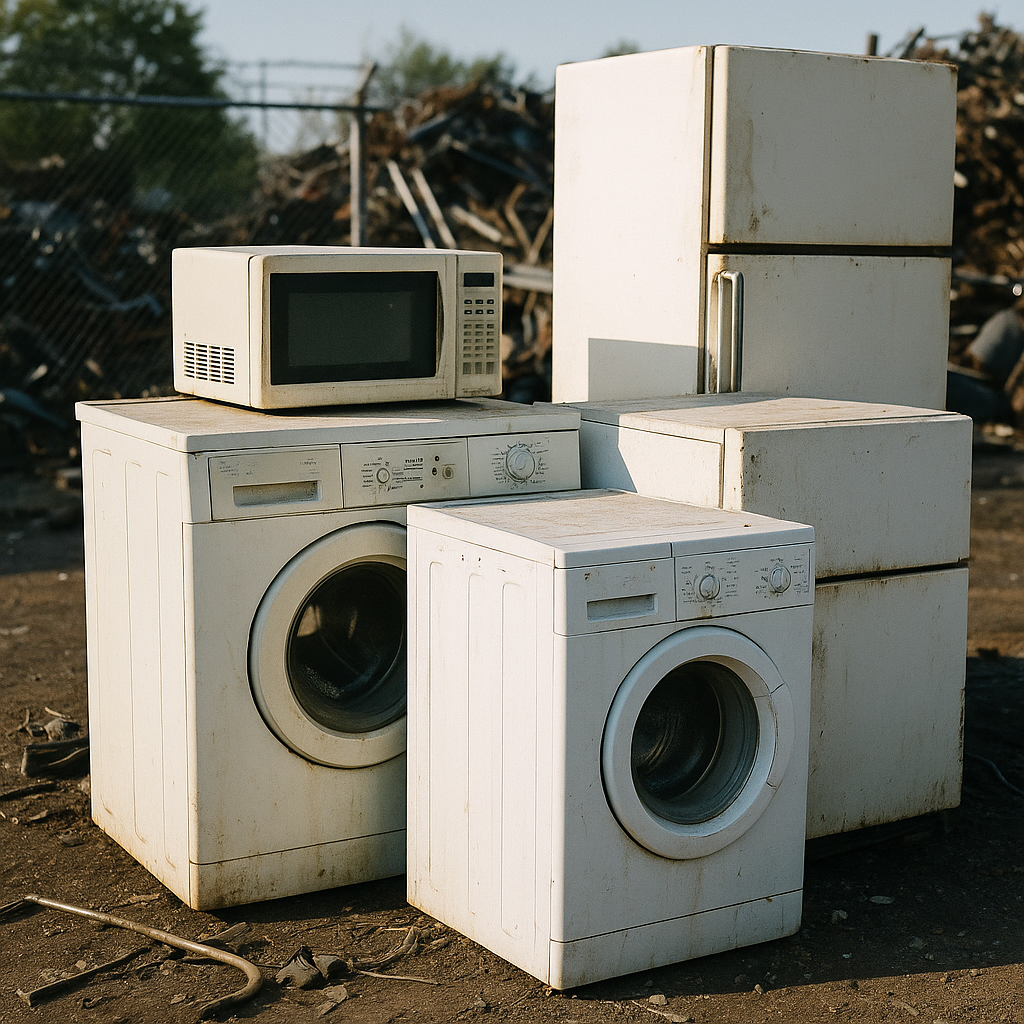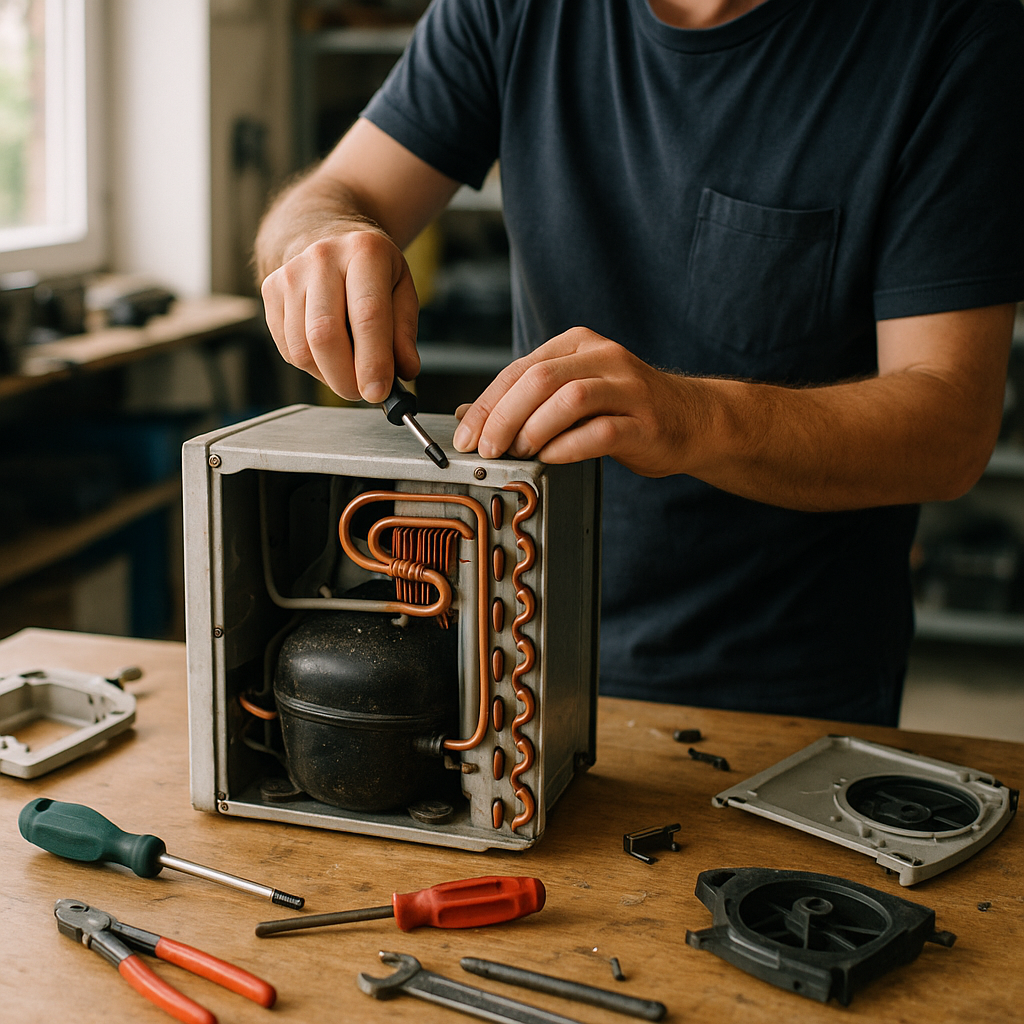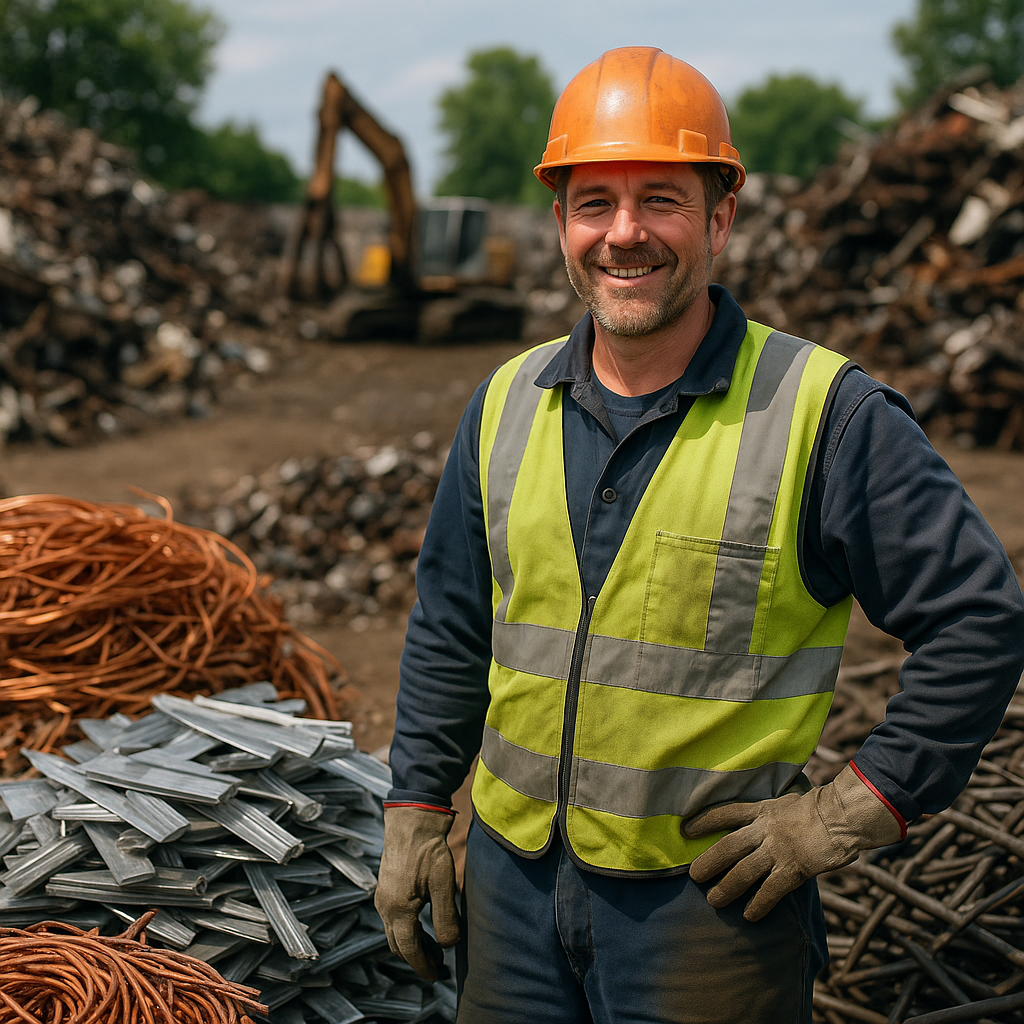5901 Botham Jean Blvd, Dallas, TX 75215
What Household Appliances Contain Valuable Scrap Metal?
July 17, 2025Take a look around your kitchen, laundry room, and garage. That old refrigerator gathering dust in the corner? The washing machine that stopped spinning last month? Even that broken toaster you’ve been meaning to replace? These everyday items are not just space-consuming clutter—they’re potential treasure troves of valuable scrap metal.
Many household appliances contain significant amounts of recyclable metal that can be recovered and repurposed. Large appliances are particularly valuable in the recycling stream. Washing machines and dryers incorporate steel frames, copper wiring, and sometimes aluminum components. Refrigerators house copper tubing, aluminum shelving, and steel casings. Ovens and air conditioners similarly pack substantial metal content that recyclers eagerly seek.
Don’t overlook smaller appliances either. Microwaves contain valuable circuit boards with gold, silver, and copper traces. Toasters feature nichrome wire heating elements and aluminum frames. Even everyday items like blenders house copper motors and stainless steel blades. The metal value in these common items often surprises homeowners who might otherwise discard them without realizing their recycling potential.
Which Metals Are Most Valuable in Appliance Recycling?

When recycling old appliances, three metals consistently stand out for their high value: copper, aluminum, and stainless steel. These materials are in demand across various industries, making them particularly worthwhile to recover from discarded appliances.
Copper: The Red Gold of Recycling
Copper tops the list as the most valuable metal commonly found in household appliances. Current market prices for scrap copper can reach $3.55 per pound for high-quality bare bright copper wire. This precious metal is primarily found in:
Refrigerator compressors, where it forms essential components of the cooling system. Electrical wiring throughout appliances, particularly in power cords and internal circuitry. Motors in washing machines, dryers, and dishwashers contain copper windings that are highly valuable.
What makes copper so valuable is its exceptional electrical conductivity and corrosion resistance. The recycling process for copper saves approximately 85% of the energy required to mine and process new copper, making it environmentally significant as well as profitable.
Aluminum: Lightweight Champion
Aluminum ranks second in value for appliance recycling, typically fetching between $0.70 to $1.00 per pound depending on quality and type. You’ll find aluminum in:
Refrigerator coils and cooling elements. Microwave frames and internal components. Air conditioning units contain substantial amounts of aluminum. Washer and dryer parts, especially in newer models designed for weight reduction.
Aluminum’s recycling value stems from its lightweight nature, durability, and the significant energy savings it offers. Recycling aluminum requires only 5% of the energy needed to produce new aluminum from raw materials, making it a recycling priority.
Stainless Steel: Durable and Dependable
While not as valuable per pound as copper or aluminum, stainless steel is present in much larger quantities in most appliances, typically selling for $0.30 to $0.40 per pound for clean, non-magnetic 300-series stainless steel. This material is commonly found in:
Refrigerator and freezer exteriors. Dishwasher tubs and interior components. Washing machine drums. Oven and range bodies and components.
Stainless steel’s value comes from its durability, resistance to corrosion, and the presence of nickel, which increases its worth. The recycling market consistently demands stainless steel for manufacturing new products.
Other Valuable Metals in Appliances
Beyond the big three, appliances may contain other valuable metals worth extracting:
Brass: Found in plumbing fixtures and some decorative elements, brass can bring $1.25 to $2.80 per pound. Circuit boards: These contain small amounts of precious metals including gold, silver, and platinum. Hard drives and memory components can be particularly valuable. Lead: Present in older appliances and batteries, lead typically sells for around $0.50 per pound for clean material.
Preparing appliances for recycling by separating these metals can significantly increase the payout. Professional recycling facilities use specialized equipment to efficiently sort and process these materials, maximizing both environmental benefits and economic returns.
What Are the Best Appliances to Scrap for Metal?

Large household appliances offer significant opportunities for metal recycling due to their high metal content. Certain appliances consistently yield better value when scrapped. Understanding which appliances contain the most valuable metals can help you maximize recycling returns.
Washing machines, dryers, refrigerators, air conditioners, and water heaters top the list of appliances worth scrapping. These items contain substantial amounts of metal by weight and house valuable metals like copper and aluminum, which command higher prices at scrap yards.
Washing Machines and Dryers
Washing machines and dryers are excellent sources of recyclable metals. They contain valuable components that make them worth dismantling before scrapping.
- Electric motors – Contain copper windings that can be separated for higher value
- Stainless steel drums – Particularly valuable in higher-end models
- Steel outer casings – Provide significant weight in recyclable steel
- Copper wiring – Found throughout the electrical systems
- Aluminum components – Present in various structural parts
A standard washing machine weighs between 150 and 200 pounds, with most of that weight coming from recyclable metals. The electric motor alone contains valuable copper, which can significantly increase the scrap value.
Refrigerators and Freezers
Refrigerators and freezers contain some of the most valuable scrap metals. However, they require special handling due to refrigerants that must be properly removed before recycling.
- Copper tubing – Extensive throughout cooling systems
- Compressors – Contain copper and other valuable metals
- Aluminum coils – Used in cooling systems
- Steel outer casings – Make up most of the weight
- Brass fittings – Found in various connection points
Many scrap yards require refrigerants to be professionally removed before they accept refrigerators or freezers for recycling. This ensures that harmful chemicals aren’t released during the recycling process.
Air Conditioners
Air conditioning units are valuable for scrapping due to their high copper and aluminum content. Both window units and central AC systems contain these metals.
- Copper coils – Extensive throughout the unit
- Aluminum fins – Used in heat exchangers
- Compressors – Contain copper windings and other metals
- Copper wiring – Throughout electrical components
- Steel housing – Outer casing and structural elements
Like refrigerators, air conditioners require proper removal of refrigerants before recycling. Even small window units contain significant amounts of copper, enhancing their scrap value.
Water Heaters
Water heaters are often overlooked as valuable scrap items. Both electric and gas models contain metals worth salvaging.
- Copper heating elements – Found in electric models
- Steel tanks – Make up the majority of the unit’s weight
- Brass valves and fittings – Located at water connection points
- Copper pipes – Used in water circulation systems
- Aluminum anodes – Found in many models to prevent corrosion
Water heaters are particularly easy to transport to scrap yards due to their cylindrical shape. Their weight and metal content make them worth recycling rather than discarding.
The value for scrapping appliances varies based on current metal prices, the condition of the appliance, and whether you’ve separated higher-value metals before recycling. Typically, scrap yards pay between $10 and $50 for major appliances, though this can increase significantly if you’ve removed and sorted valuable metals like copper and brass.
When collecting appliances for scrap, remember that separating different types of metals before taking them to a recycling facility usually results in higher payments. Copper, brass, and aluminum generally command the highest prices per pound at scrap yards.
How Can You Identify and Extract Valuable Metals From Appliances?

Discarded appliances often contain valuable metals that can be recycled and sold for profit. The key to successful metal recovery is proper identification and safe extraction techniques. With the right approach, you can transform what might seem like junk into a recycling opportunity.
Identifying Valuable Metals in Appliances
The first step in extracting valuable metals is knowing what to look for. Different appliances contain various types of metals, each with distinct values in the recycling market.
The Magnet Test: Your Primary Identification Tool
A simple magnet is an effective tool for metal identification. This test helps distinguish between two main categories of metals:
- Ferrous metals: These metals contain iron and will stick to a magnet. Steel and iron fall into this category. While less valuable than non-ferrous metals, they are still recyclable.
- Non-ferrous metals: These do not contain iron and do not stick to a magnet. Copper, aluminum, and brass are examples. These metals typically fetch higher prices at recycling centers.
Visual Identification of Common Valuable Metals
Beyond the magnet test, visual inspection can identify specific valuable metals:
Copper: Recognizable by its distinctive reddish-brown color, copper is among the most valuable metals found in appliances. Look for copper in wiring and motors of refrigerators, air conditioners, and washing machines.
Aluminum: Lighter than steel with a silver or dull gray appearance, aluminum is commonly found in refrigerator coils, microwave components, and some appliance casings.
Brass: With a yellowish appearance, brass is often found in plumbing fixtures, valves, and small electrical components in dishwashers and washing machines.
Stainless Steel: This corrosion-resistant metal is common in kitchen appliances like ovens, dishwashers, and refrigerator exteriors.
Safe Extraction of Metals from Appliances
Once you identify valuable metals, extraction should be done safely and methodically. Here’s a step-by-step guide:
Step 1: Preparation and Safety Measures
Safety should always be a priority when extracting metals. Start with these essential precautions:
- Ensure the appliance is completely unplugged and disconnected from power sources
- Wear protective gear including heavy-duty gloves, safety goggles, and appropriate clothing
- Work in a well-ventilated area to avoid inhaling dust or fumes
- Keep a first aid kit nearby
- Use proper tools such as screwdrivers, pliers, wire cutters, and wrenches
Step 2: Disassembly Process
Begin by removing external panels and non-metal components to expose the metal parts inside. Keep all screws and fasteners organized if you plan to separate different metal types.
For most appliances, focus on these high-value components:
- Motors and compressors (found in refrigerators and washing machines)
- Wiring and cables (throughout most appliances)
- Metal casings and frames
- Heating elements (in stoves and dryers)
- Coils and tubing (in refrigerators and air conditioners)
Step 3: Metal Separation and Organization
Sort the extracted metals by type to maximize recycling value. Recycling centers typically pay more for pre-sorted metals. Clean the metals by removing any plastic, rubber, or other non-metal materials.
For copper wiring, consider stripping the plastic coating to increase its value substantially. However, this process requires additional time and effort.
Special Considerations for Specific Appliances
Different appliances require specific approaches:
Refrigerators and Air Conditioners: These contain refrigerants that must be properly evacuated by a certified technician before dismantling. After professional evacuation, focus on copper tubing, aluminum coils, and compressor motors.
Washing Machines: These typically contain valuable motors, copper wiring, and steel or aluminum components. Drain any remaining water before disassembly.
Stoves and Ovens: Look for heating elements, which often contain nickel-chromium alloys, copper wiring, and stainless steel components.
Small Kitchen Appliances: Toasters, microwaves, and blenders contain circuit boards with gold-plated components, copper wiring, and various metal casings.
Responsible Recycling Practices
After extraction, ensure proper disposal of non-recyclable components. Many communities have designated e-waste or appliance recycling centers for safe disposal of potentially hazardous materials.
While extracting valuable metals from appliances can be profitable, always prioritize safety and environmental responsibility over maximum metal recovery. Proper handling and recycling of these materials significantly contribute to conservation efforts and reduce the need for virgin metal mining.
Conclusion: Maximizing value from appliance recycling

Recycling old appliances offers substantial financial and environmental benefits when done properly. Refrigerators, air conditioners, and washing machines typically yield the highest returns due to their valuable copper, aluminum, and stainless steel components. Identifying and separating high-value metals like copper wiring, aluminum coils, and brass fittings beforehand can significantly increase your returns. Proper handling of hazardous materials, such as refrigerants, is vital for safety and environmental protection.
Take a fresh look at the unused appliances gathering dust in your garage or basement. Rather than viewing them as junk, recognize them as valuable resources that can be transformed into raw materials for new products.
For professional assistance with appliance recycling that ensures maximum value recovery and environmental compliance, contact Okon Recycling at 214-717-4083.
